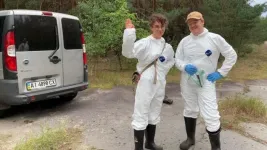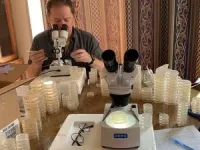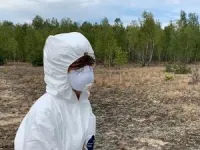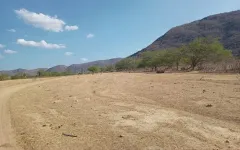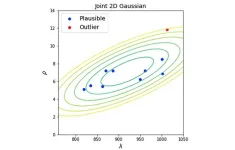(Press-News.org) The 1986 disaster at the Chornobyl nuclear power plant transformed the surrounding area into the most radioactive landscape on Earth. Humans were evacuated, but many plants and animals continue to live in the region, despite the high levels of radiation that persist nearly four decades later.
A new study led by researchers at New York University finds that exposure to chronic radiation from Chornobyl has not damaged the genomes of microscopic worms living there today—which doesn’t mean that the region is safe, the scientists caution, but suggests that these worms are exceptionally resilient.
In recent years, researchers have found that some animals living in the Chornobyl Exclusion Zone—the region in northern Ukraine within an 18.6-mile radius of the power plant—are physically and genetically different from their counterparts elsewhere, raising questions about the impact of chronic radiation on DNA.
“Chornobyl was a tragedy of incomprehensible scale, but we still don't have a great grasp on the effects of the disaster on local populations,” said Sophia Tintori, a postdoctoral associate in the Department of Biology at NYU and the first author of the study, published in the Proceedings of the National Academy of Sciences (PNAS). “Did the sudden environmental shift select for species, or even individuals within a species, that are naturally more resistant to ionizing radiation?”
To dig into this, Tintori and her colleagues turned to nematodes, tiny worms with simple genomes and rapid reproduction, which makes them particularly useful for understanding basic biological phenomena.
“These worms live everywhere, and they live quickly, so they go through dozens of generations of evolution while a typical vertebrate is still putting on its shoes,” said Matthew Rockman, a professor of biology at NYU and the study’s senior author.
“I had seen footage of the exclusion zone and was surprised by how lush and overgrown it looked—I'd never thought of it as teeming with life,” added Tintori. “If I want to find worms that are particularly tolerant to radiation exposure, this is a landscape that might have already selected for that.”
The worms of Chornobyl
In collaboration with scientists in Ukraine and U.S. colleagues—including biologist Timothy Mousseau of the University of South Carolina, who studies the effects of radiation from the Chornobyl and Fukushima disasters—Tintori and Rockman visited the Chornobyl Exclusion Zone in 2019 to see if chronic radiation has had a detectable impact on the region’s worms. With Geiger counters in hand to measure local levels of radiation and personal protective gear to guard against radioactive dust, they gathered worms from samples of soil, rotting fruit, and other organic material. Worms were collected from locations throughout the zone with different amounts of radiation, ranging from low levels on par with New York City (negligibly radioactive) to high-radiation sites on par with outer space (dangerous for humans, but of unclear if it would be dangerous to worms).
After collecting samples in the field, the team brought them to Mousseau’s field lab in a former residential home in Chornobyl, where they separated hundreds of nematodes from the soil or fruit. From there, they headed to a Kyiv hotel where, using travel microscopes, they isolated and established cultures from each worm.
Back in the lab at NYU, the researchers continued studying the worms—part of which involved freezing them.
“We can cryopreserve worms, and then thaw them for study later. That means that we can stop evolution from happening in the lab, something impossible with most other animal models, and very valuable when we want to compare animals that have experienced different evolutionary histories,” said Rockman.
They focused their analyses on 15 worms of a nematode species called Oscheius tipulae, which has been used in genetic and evolutionary studies. They sequenced the genomes of the 15 O. tipulae worms from Chornobyl and compared them with the genomes of five O. tipulae from other parts of the world.
Different DNA—but not due to radiation
The researchers were surprised to find that, using several different analyses, they could not detect a signature of radiation damage on the genomes of the worms from Chornobyl.
“This doesn't mean that Chornobyl is safe—it more likely means that nematodes are really resilient animals and can withstand extreme conditions,” noted Tintori. “We also don’t know how long each of the worms we collected was in the Zone, so we can't be sure exactly what level of exposure each worm and its ancestors received over the past four decades.”
Wondering whether the lack of genetic signature was because the worms living in Chornobyl are unusually effective at protecting or repairing their DNA, the researchers designed a system to compare how quickly populations of worms grow and used it to measure how sensitive the descendants of each of the 20 genetically distinct worms were to different types of DNA damage.
While the lineages of worms were different from each other in how well they tolerated DNA damage, these differences didn't correspond to the levels of radiation at each collection site. Their findings suggest that worms from Chornobyl are not necessarily more tolerant of radiation and the radioactive landscape has not forced them to evolve.
What worms can teach us about our own biology
The results give researchers clues into how DNA repair can vary from individual to individual—and despite the genetic simplicity of O. tipulae, could lead to a better understanding of natural variation in humans.
“Now that we know which strains of O. tipulae are more sensitive or more tolerant to DNA damage, we can use these strains to study why different individuals are more likely than others to suffer the effects of carcinogens,” said Tintori.
How different individuals in a species respond to DNA damage is top of mind for cancer researchers seeking to understand why some humans with a genetic predisposition to cancer develop the disease, while others do not.
“Thinking about how individuals respond differently to DNA-damaging agents in the environment is something that will help us have a clear vision of our own risk factors,” added Tintori.
Additional study authors include Derin Çağlar and Patrick Ortiz of NYU, Timothy Mousseau of the University of South Carolina, and Ihor Chyzhevskyi of the State Specialized Enterprise "Ecocentre" in Ukraine. The research was funded by the National Institutes of Health (ES031364, ES029930, GM141906, P40 OD010440), Damon Runyon Cancer Research Foundation (DRG-2371-19), Samuel Freeman Charitable Trust, and the Zegar Foundation.
END
Tiny worms tolerate chornobyl radiation
Identifying animals resilient to DNA damage may provide clues for human risk factors
2024-03-05
ELSE PRESS RELEASES FROM THIS DATE:
Restoration of degraded areas in semi-arid region contributes to ‘return’ of soil microorganisms, study shows
2024-03-05
Strategies deployed for the restoration of degraded land have had promising results in Brazil’s semi-arid region, improving the microbial properties of the soil and contributing to a return of native ecosystem services. The techniques include removal of cattle or restriction of their access to specific areas of pasture; cultivation of cover crops; and terracing to control erosion. Recovery of soil microbial properties maintains biodiversity and raises crop yields, contributing to agricultural ...
New research details negative consumer impacts of BLM support on major companies and brands
2024-03-05
INFORMS Journal Marketing Science New Study Key Takeaways:
Brands that supported BLM on social media during the height of the movement suffered negative impacts on social media.
Negative impacts were felt from both Democratic and Republican consumers.
The ‘bandwagon effect’ was one of the more significant factors.
Some brands with more historical prosocial posting on social media and socially oriented missions suffer less from the negative effects and may even benefit from supporting ...
Having self-control leads to power
2024-03-05
Out-of-control behavior by CEOs and other powerful people constantly makes headlines – so much so that some might consider impulsivity a pathway to power. New research from the UC San Diego Rady School of Management and Texas A&M University finds that having self-control is often what leads to power.
In a paper published in the Journal of Personality and Social Psychology, researchers find that showing self-control influences how powerful an individual is perceived to be by their peers, as well as how much power they are granted by those peers. In a series of seven experiments with roughly 3,500 participants, both students ...
Endocrine Society elects Lange as 2025-2026 President
2024-03-05
WASHINGTON—Endocrine Society members elected Carol Lange, Ph.D., of the University of Minnesota in Minneapolis, Minn., as its 2025-2026 President. She will serve as President-Elect for a year beginning in June 2024 before becoming President in June 2025.
Lange is a Professor of Medicine and Molecular Pharmacology and Therapeutics, holds the Tickle Family Land Grant Endowed Chair of Breast Cancer Research, and is the Associate Director for Basic Science and the Director of the Molecular, Genetic, and Cellular Targets of Cancer Training Program at the University of Minnesota Masonic ...
March issues of APA journals cover new insights into treatments for anxiety, depression, substance use disorder, ADHD and more
2024-03-05
WASHINGTON, D.C., March 5, 2024 — The latest issues of two American Psychiatric Association journals, The American Journal of Psychiatry and Psychiatric Services are now available online.
The March issue of The American Journal of Psychiatry features studies that focus on new insights into treatments across the lifespan. Highlights include:
Normalization of Fronto-Parietal Activation by Cognitive-Behavioral Therapy in Unmedicated Pediatric Patients With Anxiety Disorders. (AJP Deputy Editor ...
Does iron accumulate in brain after concussions?
2024-03-05
EMBARGOED FOR RELEASE UNTIL 4 P.M. ET, TUESDAY, MARCH 5, 2024
MINNEAPOLIS – People who have headaches after experiencing concussions may also be more likely to have higher levels of iron in areas of the brain, which is a sign of injury to brain cells, according to a preliminary study released today, March 5, 2024, that will be presented at the American Academy of Neurology’s 76th Annual Meeting taking place April 13–18, 2024, in person in Denver and online.
“These results suggest that iron accumulation in the brain can be used as a biomarker for concussion and post-traumatic ...
Salk Professor Terrence Sejnowski wins Brain Prize
2024-03-05
LA JOLLA—(March 5, 2024) Salk Institute Professor Terrence Sejnowski will receive the 2024 Brain Prize for “pioneering the field of computational and theoretical neuroscience, making seminal contributions to our understanding of the brain, and paving the way for the development of brain-inspired artificial intelligence,” the Lundbeck Foundation announced today.
Sejnowski shares the prize—the world’s top recognition in neuroscience, totaling 10 million DKK (approximately $1.5 million)—with Larry Abbott of Columbia University and Haim Sompolinsky of Harvard University and Hebrew ...
A call for standardization of controls in lifespan studies
2024-03-05
“[...] we posit that the majority of results in biology of aging may be irrelevant to the fundamental aim of this field and must be acknowledged appropriately.”
BUFFALO, NY- March 5, 2024 – A new research perspective was published in Aging (listed by MEDLINE/PubMed as "Aging (Albany NY)" and "Aging-US" by Web of Science) Volume 16, Issue 4, entitled, “On standardization of controls in lifespan studies.”
In this new paper, researchers Olga Spiridonova, Dmitrii Kriukov, Nikolai Nemirovich-Danchenko, and Leonid Peshkin from Harvard Medical ...
How bias shows up in maps made with citizen science data
2024-03-05
When biologist Elizabeth Carlen pulled up in her 2007 Subaru for her first look around St. Louis, she was already checking for the squirrels. Arriving as a newcomer from New York City, Carlen had scrolled through maps and lists of recent sightings in a digital application called iNaturalist. This app is a popular tool for reporting and sharing sightings of animals and plants.
People often start using apps like iNaturalist and eBird when they get interested in a contributory science project (also sometimes called a citizen science project). Armed with cellphones equipped with cameras and GPS, app-wielding volunteers can submit geolocated data that iNaturalist then translates into user-friendly ...
Rice’s Nai-Hui Chia wins NSF CAREER Award
2024-03-05
HOUSTON – (March 5, 2024) – Nai-Hui Chia, an assistant professor of computer science at Rice University, has won a National Science Foundation CAREER Award to develop a new theoretical framework to facilitate the development of efficient quantum algorithms for a range of problems in quantum physics and computer science as well as enhance the security of quantum cryptography.
The highly competitive grants are awarded each year to a selective cohort of about 500 early career faculty across all disciplines engaged in pathbreaking research and committed to growing their field through outreach and education.
“Quantum computing holds immense ...
LAST 30 PRESS RELEASES:
Numbers in our sights affect how we perceive space
SIMJ announces global collaborative book project in commemoration of its 75th anniversary
Air pollution exposure and birth weight
Obstructive sleep apnea risk and mental health conditions among older adults
How talking slows eye movements behind the wheel
The Ceramic Society of Japan’s Oxoate Ceramics Research Association launches new international book project
Heart-brain connection: international study reveals the role of the vagus nerve in keeping the heart young
Researchers identify Rb1 as a predictive biomarker for a new therapeutic strategy in some breast cancers
Survey reveals ethical gaps slowing AI adoption in pediatric surgery
Stimulant ADHD medications work differently than thought
AI overestimates how smart people are, according to HSE economists
HSE researchers create genome-wide map of quadruplexes
Scientists boost cell "powerhouses" to burn more calories
Automatic label checking: The missing step in making reliable medical AI
Low daily alcohol intake linked to 50% heightened mouth cancer risk in India
American Meteorological Society announces Rick Spinrad as 2026 President-Elect
Biomass-based carbon capture spotlighted in newly released global climate webinar recording
Illuminating invisible nano pollutants: advanced bioimaging tracks the full journey of emerging nanoscale contaminants in living systems
How does age affect recovery from spinal cord injury?
Novel AI tool offers prognosis for patients with head and neck cancer
Fathers’ microplastic exposure tied to their children’s metabolic problems
Research validates laboratory model for studying high-grade serous ovarian cancer
SIR 2026 delivers transformative breakthroughs in minimally invasive medicine to improve patient care
Stem Cell Reports most downloaded papers of 2025 highlight the breadth and impact of stem cell research
Oxford-led study estimates NHS spends around 3% of its primary and secondary care budget on the health impacts of heat and cold in England
A researcher’s long quest leads to a smart composite breakthrough
Urban wild bees act as “microbial sensors” of city health.
New study finds where you live affects recovery after a hip fracture
Forecasting the impact of fully automated vehicle adoption on US road traffic injuries
Alcohol-related hospitalizations from 2016 to 2022
[Press-News.org] Tiny worms tolerate chornobyl radiationIdentifying animals resilient to DNA damage may provide clues for human risk factors
